Modeling Nonlinear Aeroelastic Forces for Bridge Decks with Various Leading Edges Using LSTM Networks
Abstract
:1. Introduction
2. Numerical Simulation of LCO
2.1. Governing Equations
2.2. Computational Domain and Mesh Arrangement
2.3. Wind–Bridge Interaction
2.4. CFD Validation
2.5. CFD Simulation
3. LSTM Network
3.1. Forward Pass of LSTM Network
3.2. Back Pass of LSTM Network with a Hybrid Loss Function
3.3. LSTM Training
4. LSTM Network Simulation Results
5. Concluding Remarks
Author Contributions
Funding
Institutional Review Board Statement
Informed Consent Statement
Data Availability Statement
Conflicts of Interest
References
- Scanlan, R.H.; Tomko, J.J. Airfoil and Bridge Deck Flutter Derivatives. J. Eng. Mech. Div. 1971, 97, 1717–1737. [Google Scholar] [CrossRef]
- Scanlan, R.H.; Lin, W.-H. Effects of Turbulence on Bridge Flutter Derivatives. J. Eng. Mech. Div. 1978, 104, 719–733. [Google Scholar] [CrossRef]
- Sarkar, P.P.; Jones, N.P.; Scanlan, R.H. Identification of Aeroelastic Parameters of Flexible Bridges. J. Eng. Mech. 1994, 120, 1718–1742. [Google Scholar] [CrossRef]
- Scanlan, R.H. Amplitude and Turbulence Effects on Bridge Flutter Derivatives. J. Struct. Eng. 1997, 123, 232–236. [Google Scholar] [CrossRef]
- Xu, F.; Zhu, L.; Ge, X.; Zhang, Z. Some New Insights into the Identification of Bridge Deck Flutter Derivatives. Eng. Struct. 2014, 75, 418–428. [Google Scholar] [CrossRef]
- Zhu, Z.; Gu, M. Identification of Flutter Derivatives of Bridge Decks Using CFD-Based Discrete-Time Aerodynamic Models. Wind. Struct. 2014, 18, 215–233. [Google Scholar] [CrossRef]
- Wu, T.; Kareem, A. Aerodynamics and Aeroelasticity of Cable-Supported Bridges: Identification of Nonlinear Features. J. Eng. Mech. 2013, 139, 1886–1893. [Google Scholar] [CrossRef]
- Wu, T.; Kareem, A.; Li, S. On the Excitation Mechanisms of Rain–Wind Induced Vibration of Cables: Unsteady and Hysteretic Nonlinear Features. J. Wind. Eng. Ind. Aerodyn. 2013, 122, 83–95. [Google Scholar] [CrossRef]
- Xu, F.Y.; Chen, A.R. Flutter Test and Analysis for the Suramadu Bridge in Indonesia. China Civ. Eng. J. 2009, 42, 35–40. [Google Scholar] [CrossRef]
- Zhu, L.; Gao, G. Influential Factors of Soft Flutter Phenomenon for Typical Bridge Deck Sections. Biol. Sci. 2015, 43, 1289–1294+1382. [Google Scholar] [CrossRef]
- Xu, F.; Wu, T.; Ying, X.; Kareem, A. Higher-Order Self-Excited Drag Forces on Bridge Decks. J. Eng. Mech. 2016, 142, 06015007. [Google Scholar] [CrossRef]
- Ying, X.; Xu, F.; Zhang, M.; Zhang, Z. Numerical Explorations of the Limit Cycle Flutter Characteristics of a Bridge Deck. J. Wind. Eng. Ind. Aerodyn. 2017, 169, 30–38. [Google Scholar] [CrossRef]
- Náprstek, J.; Pospíšil, S.; Hračov, S. Analytical and Experimental Modelling of Non-Linear Aeroelastic Effects on Prismatic Bodies. J. Wind. Eng. Ind. Aerodyn. 2007, 95, 1315–1328. [Google Scholar] [CrossRef]
- Wu, T.; Kareem, A. Simulation of Nonlinear Bridge Aerodynamics: A Sparse Third-Order Volterra Model. J. Sound Vib. 2014, 333, 178–188. [Google Scholar] [CrossRef]
- Wu, T.; Kareem, A. A Nonlinear Analysis Framework for Bluff-Body Aerodynamics: A Volterra Representation of the Solution of Navier-Stokes Equations. J. Fluids Struct. 2015, 54, 479–502. [Google Scholar] [CrossRef]
- Gao, G.; Zhu, L.; Han, W.; Li, J. Nonlinear Post-Flutter Behavior and Self-Excited Force Model of a Twin-Side-Girder Bridge Deck. J. Wind. Eng. Ind. Aerodyn. 2018, 177, 227–241. [Google Scholar] [CrossRef]
- Zhang, M.; Xu, F.; Zhang, Z.; Ying, X. Energy Budget Analysis and Engineering Modeling of Post-Flutter Limit Cycle Oscillation of a Bridge Deck. J. Wind. Eng. Ind. Aerodyn. 2019, 188, 410–420. [Google Scholar] [CrossRef]
- Zhang, M.; Wu, T.; Xu, F. Vortex-Induced Vibration of Bridge Decks: Describing Function-based Model. J. Wind. Eng. Ind. Aerodyn. 2019, 195, 104016. [Google Scholar] [CrossRef]
- Wu, T.; Snaiki, R. Applications of Machine Learning to Wind Engineering. Front. Built Environ. 2022, 8, 811460. [Google Scholar] [CrossRef]
- Glorot, X.; Bengio, Y. Understanding the Difficulty of Training Deep Feedforward Neural Networks. In Proceedings of the Thirteenth International Conference on Artificial Intelligence and Statistics, JMLR Workshop and Conference Proceedings, Sardinia, Italy, 31 March 2010; pp. 249–256. [Google Scholar]
- Graves, A. Generating Sequences with Recurrent Neural Networks. arXiv 2013, arXiv:1308.0850. [Google Scholar] [CrossRef]
- Wei, S.; Jin, X.; Li, H. General Solutions for Nonlinear Differential Equations: A Rule-Based Self-Learning Approach Using Deep Reinforcement Learning. Comput. Mech. 2019, 64, 1361–1374. [Google Scholar] [CrossRef]
- Wu, T.; Kareem, A. Modeling Hysteretic Nonlinear Behavior of Bridge Aerodynamics via Cellular Automata Nested Neural Network. J. Wind. Eng. Ind. Aerodyn. 2011, 99, 378–388. [Google Scholar] [CrossRef]
- Bengio, Y.; Simard, P.; Frasconi, P. Learning Long-Term Dependencies with Gradient Descent Is Difficult. IEEE Trans. Neural Netw. 1994, 5, 157–166. [Google Scholar] [CrossRef] [PubMed]
- Gers, F.A.; Schmidhuber, J.; Cummins, F. Continual Prediction Using LSTM with Forget Gates. In Perspectives in Neural Computing, Proceedings of the Neural Nets WIRN Vietri-99, Salerno, Italy, 20–22 May 1999; Marinaro, M., Tagliaferri, R., Eds.; Springer: London, UK, 1999; pp. 133–138. [Google Scholar]
- Mannarino, A.; Mantegazza, P. Nonlinear Aeroelastic Reduced Order Modeling by Recurrent Neural Networks. J. Fluids Struct. 2014, 48, 103–121. [Google Scholar] [CrossRef]
- Wang, R.; Kalnay, E.; Balachandran, B. Neural Machine-Based Forecasting of Chaotic Dynamics. Nonlinear Dyn. 2019, 98, 2903–2917. [Google Scholar] [CrossRef]
- Zhang, W.; Wang, B.; Ye, Z.; Quan, J. Efficient Method for Limit Cycle Flutter Analysis Based on Nonlinear Aerodynamic Reduced-Order Models. AIAA J. 2012, 50, 1019–1028. [Google Scholar] [CrossRef]
- Li, K.; Kou, J.; Zhang, W. Deep Neural Network for Unsteady Aerodynamic and Aeroelastic Modeling across Multiple Mach Numbers. Nonlinear Dyn. 2019, 96, 2157–2177. [Google Scholar] [CrossRef]
- Li, T.; Wu, T.; Liu, Z. Nonlinear Unsteady Bridge Aerodynamics: Reduced-Order Modeling Based on Deep LSTM Networks. J. Wind. Eng. Ind. Aerodyn. 2020, 198, 104116. [Google Scholar] [CrossRef]
- Li, T.; Wu, T. Modeling Nonlinear Flutter Behavior of Long-Span Bridges using Knowledge-Enhanced Long Short-Term Memory Network. Comput. Aided Civ. Infrastruct. Eng. 2023, 1–16. [Google Scholar] [CrossRef]
- Li, W.; Laima, S.; Jin, X.; Yuan, W.; Li, H. A Novel Long Short-Term Memory Neural-Network-Based Self-Excited Force Model of Limit Cycle Oscillations of Nonlinear Flutter for Various Aerodynamic Configurations. Nonlinear Dyn. 2020, 100, 2071–2087. [Google Scholar] [CrossRef]
- Wang, H.; Wu, T. Knowledge-Enhanced Deep Learning for Wind-Induced Nonlinear Structural Dynamic Analysis. J. Struct. Eng. 2020, 146, 04020235. [Google Scholar] [CrossRef]
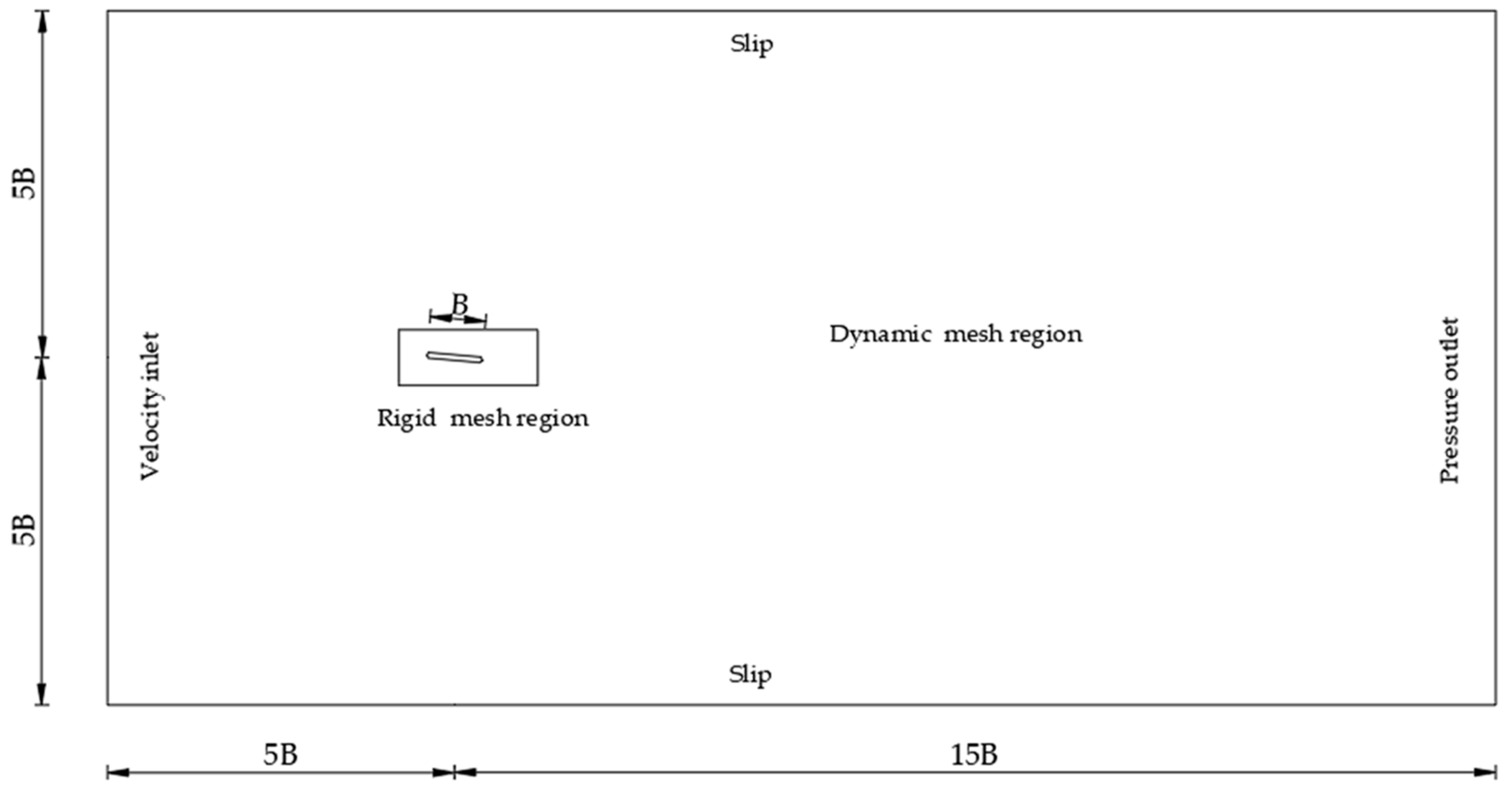




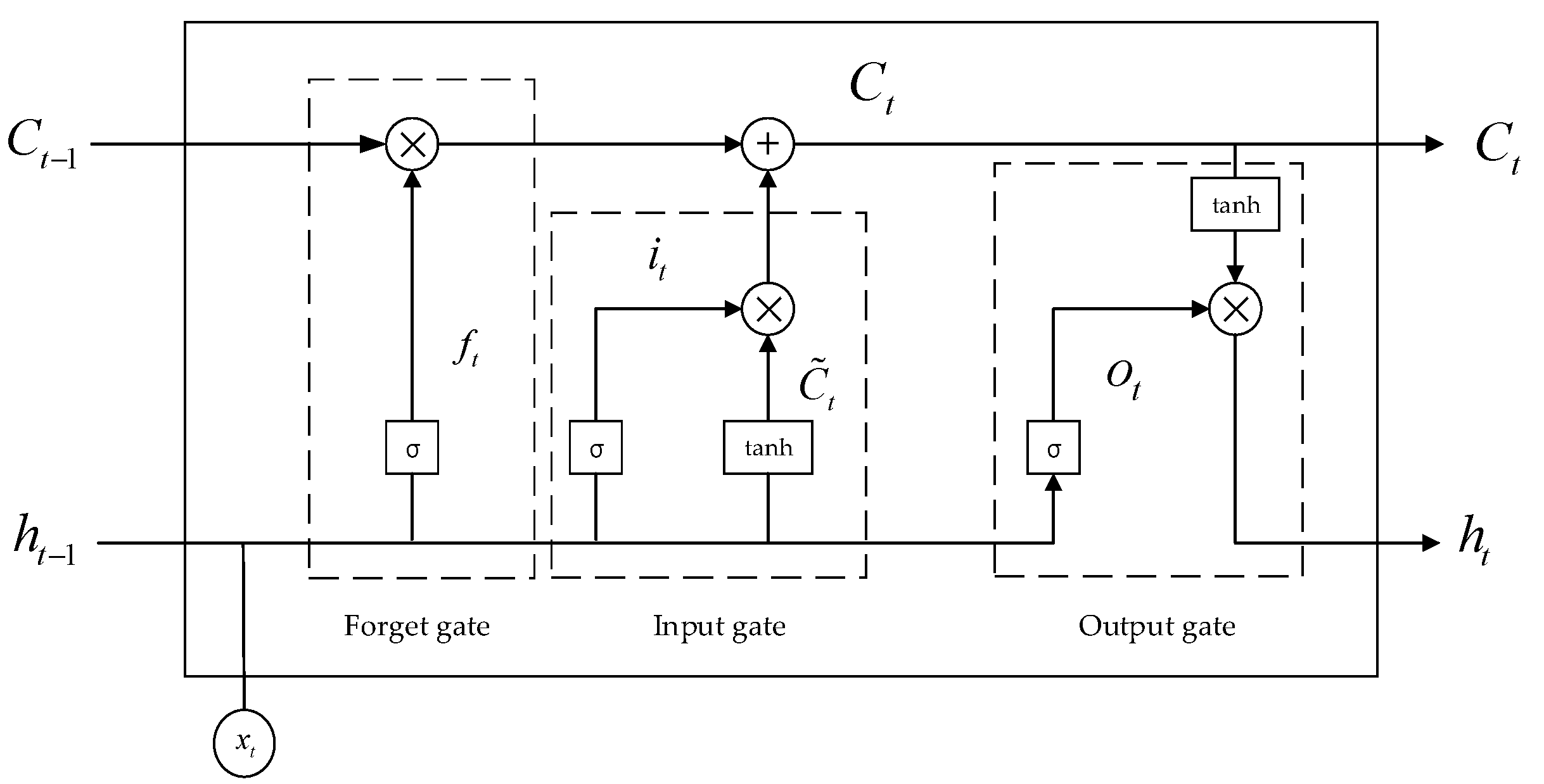
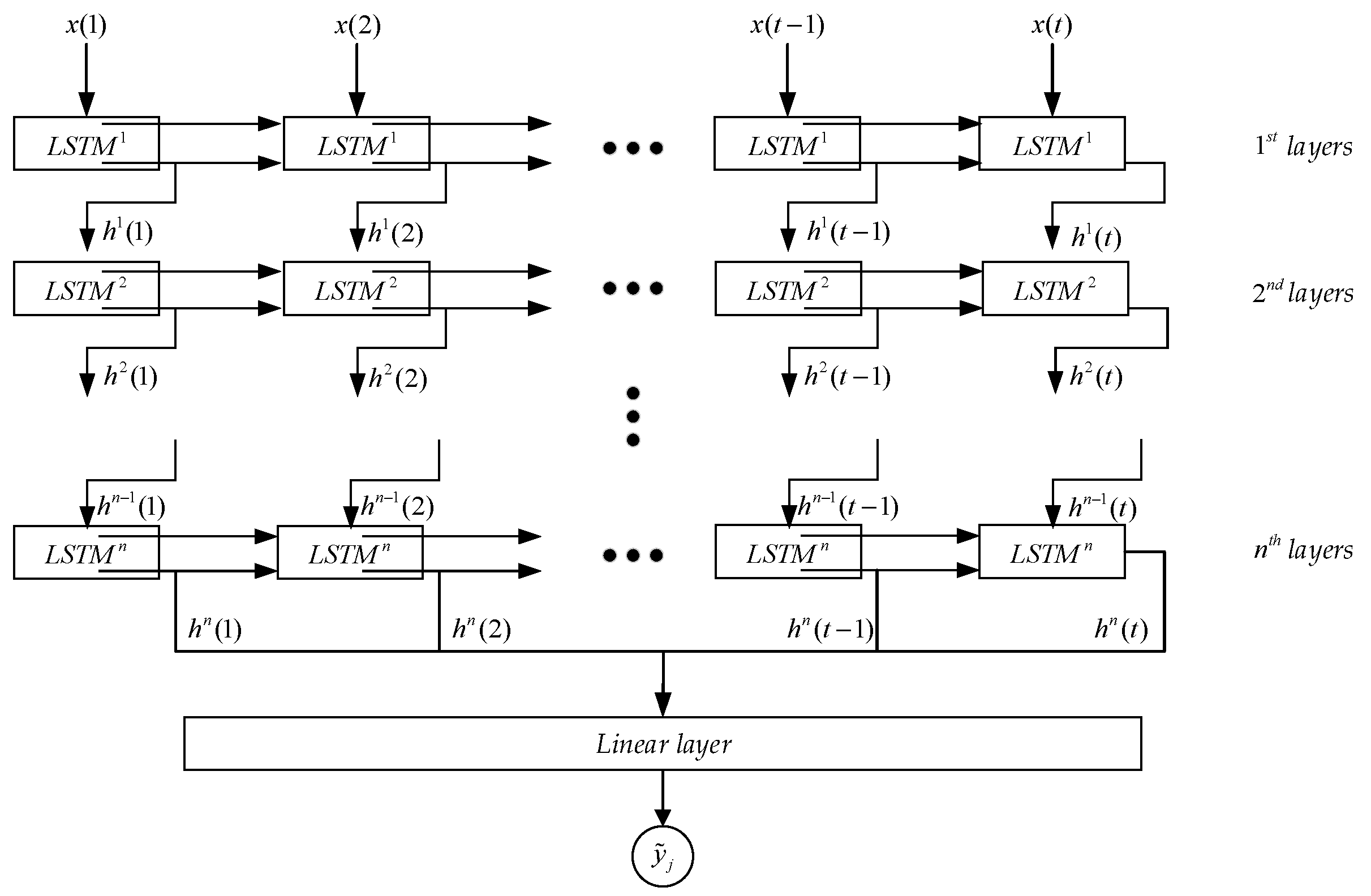




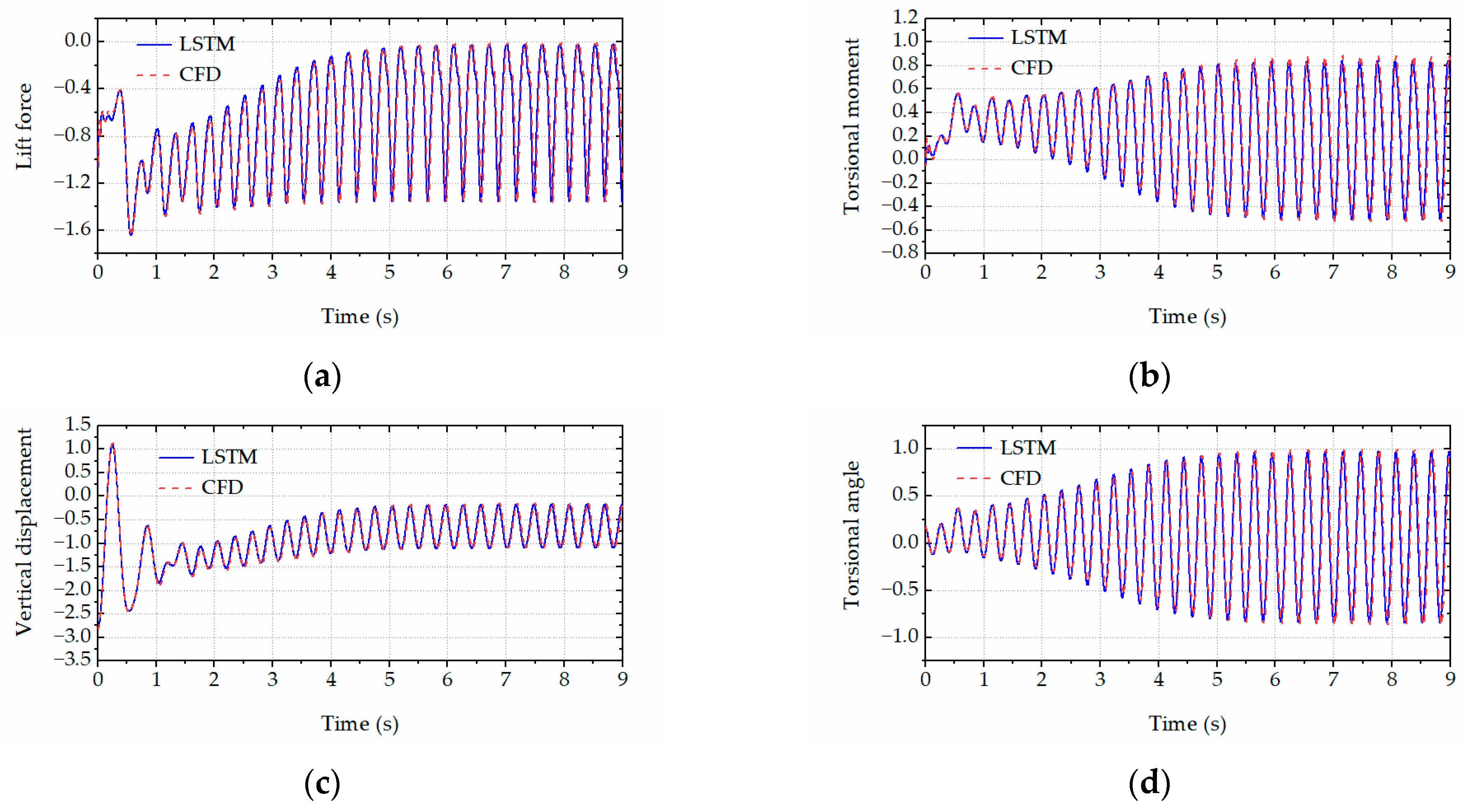
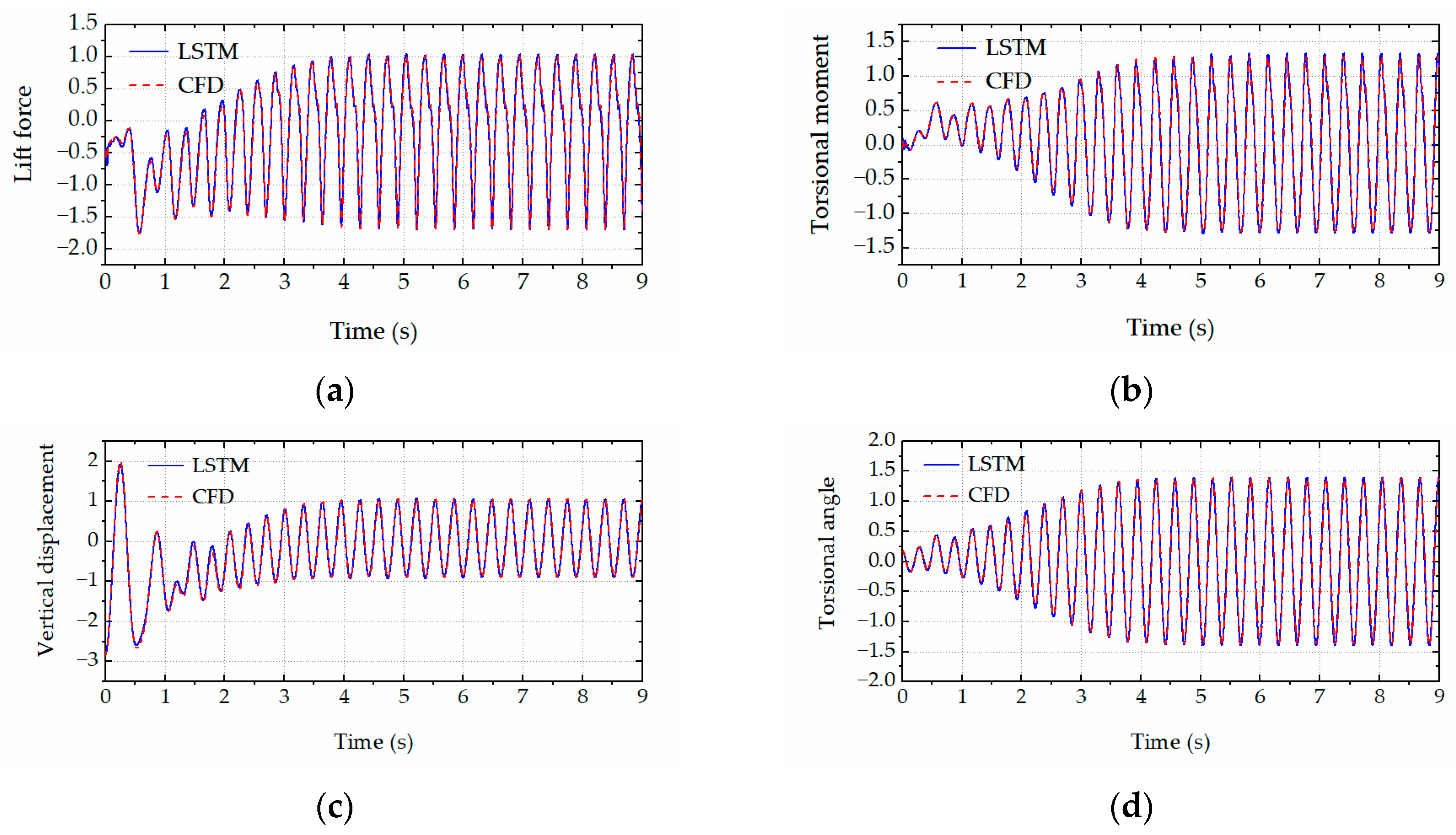


| CFD Result | Experimental Result | Relative Error | |
|---|---|---|---|
| Critical wind speed (m/s) | 19.3 | 19.4 | 0.5% |
| CFD Results | Experimental Results | Relative Error | |
|---|---|---|---|
| Vertical amplitude (h/B) | 0.0092 | 0.0097 | 5.1% |
| Torsional amplitude (rad) | 0.0955 | 0.0977 | 2.2% |
| B (m) | H (m) | m (kg/m) | Im (kg·m2/m) | fh (Hz) | fα (Hz) | ξh = ξα |
|---|---|---|---|---|---|---|
| 0.8 | 0.08 | 12.00 | 0.44 | 2.01 | 3.79 | 0.005 |
Disclaimer/Publisher’s Note: The statements, opinions and data contained in all publications are solely those of the individual author(s) and contributor(s) and not of MDPI and/or the editor(s). MDPI and/or the editor(s) disclaim responsibility for any injury to people or property resulting from any ideas, methods, instructions or products referred to in the content. |
© 2023 by the authors. Licensee MDPI, Basel, Switzerland. This article is an open access article distributed under the terms and conditions of the Creative Commons Attribution (CC BY) license (https://creativecommons.org/licenses/by/4.0/).
Share and Cite
An, X.; Li, S.; Wu, T. Modeling Nonlinear Aeroelastic Forces for Bridge Decks with Various Leading Edges Using LSTM Networks. Appl. Sci. 2023, 13, 6005. https://doi.org/10.3390/app13106005
An X, Li S, Wu T. Modeling Nonlinear Aeroelastic Forces for Bridge Decks with Various Leading Edges Using LSTM Networks. Applied Sciences. 2023; 13(10):6005. https://doi.org/10.3390/app13106005
Chicago/Turabian StyleAn, Xingyu, Shaopeng Li, and Teng Wu. 2023. "Modeling Nonlinear Aeroelastic Forces for Bridge Decks with Various Leading Edges Using LSTM Networks" Applied Sciences 13, no. 10: 6005. https://doi.org/10.3390/app13106005
APA StyleAn, X., Li, S., & Wu, T. (2023). Modeling Nonlinear Aeroelastic Forces for Bridge Decks with Various Leading Edges Using LSTM Networks. Applied Sciences, 13(10), 6005. https://doi.org/10.3390/app13106005







